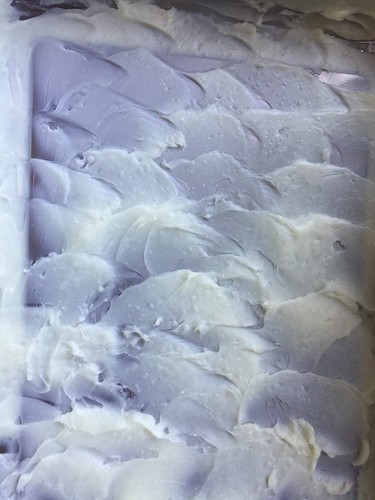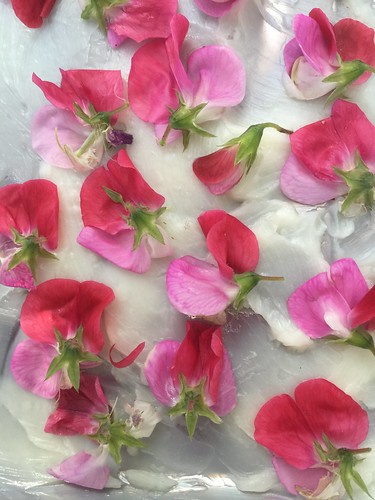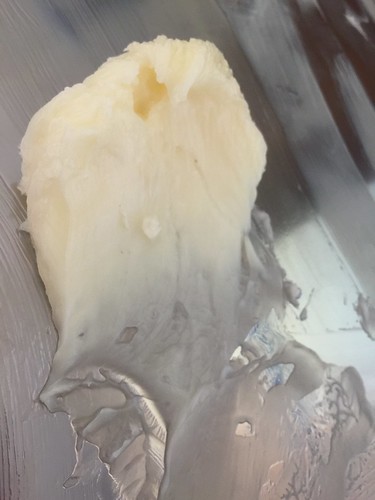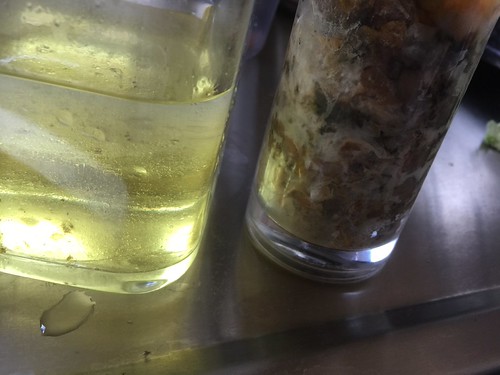Enfleurage Experiments

This spring, I have been experimenting with vegan enfleurage (the traditional enfleurage uses animal fats - ideally a combination of lard and tallow; which as a vegetarian I'm not interested in using). I tried different vegan fats (oils that are solid at room temperature), which I slabbed on a stainless steel pan with a lid (the kind you'd use, steeped in a hot batch, in catering carts to keep the food warm). I smeared both the lid and the tray with fat, so that the flowers get encapsulated by the scent-absorbging fats, an you can truly capture some of the "headspace" of the perfume. After all, this is what enfleurage is all about!
I tried different fats - such as palm, shea butter, coconut oil, etc. with varying results and also different challenges in the process, which I feel compelled to share here in case you want to experiment with your own enfleurage with your flowers.
I tried many different flowers - whatever was in bloom. My first fantasy was to use the Calicotome villosa flowers (they look very similar to gorse flowers), but they bloomed very early and I didn't have my tray then yet. Then I was hoping to get the broom; but I could not figure out yet what is the best time of the day to pick them. This was a crucial detail, because I don't have them growing close by, and didn't want them to spoil on the way to the tray. A technical difficulty that I could not anticipate was that the fats melt very fast if you take the tray out with you to harvest. And then you end up with some serious problems (such as the fats on the lid drip off to the bottom). And that is defeating the whole purpose...

So, in the end, I created mixed trays of flowers, whatever I had on hand that was blooming, and paid close attention to the time of the day when it's best to capture them. Some are best early in the morning (not too many, actually), others you'll need to wait till the sun is shining (late morning). The Trachelospermum jasminoides flowers give their very best incensed-ambery-jasmine in the afternoon. And some, like the gardenias and Brunflesia, truly are best at night. The sweetpeas and Buddleijas davidii are most forgiving. But all are also favoured by tiny, minuscule bugs, which I found some ways to reduce, but very few ways to completely avoid completely.

After changing the flowers for several batches, of the course of a week or more I got what is technically called "Pommade". This is the fats saturated with the flowers' perfume. But to get to this phase you got to be utterly careful not to let the flowers overstay their welcome. You must change them every two days. Also, you must pay close attention to not allow any mould to form. The problem is, there is not a lot of ways to know when the mould will form - until it actually started. The literature I found about enfleurage talks about only week-long processing of the flowers, changing them every two days. But the fats did not have that much fragrance after a week. Also, mould could form within that week, depending not he amount of moisture in the atmosphere - and in the flowers.

The pommade is then washed with alcohol, or to be more exact: it is melted over low heat bain-marie with alcohol. Allowed to macerate for additional ten weeks. Then chilled and filtered. What you see in the image below is the warmed fats in the alcohol (on the left) and the spent flowers (the beaker on the right). The spent flowers can be composted, or extracted with absolute to create an "absolute from chassis".

The resulting alcohol is really a perfume - alcohol with the plants essences in them. This is what you'll find in many old formula book labeled as "extrait of tuberose", "extrait of jasmine", and so on and so forth. This is not the complete process, but this is probably where a home enfleurageur should stop, to avoid unnecessary loss of material. And especially, if you're intending to use this in alcoholic perfumes anyway. Serious (read: commercial) enfleurage manufacturers would go on to evaporate the alcohol (preferably with a still, and in such way that they can re-use it), and will be left with an uber concentrated absolute from enfleurage.

